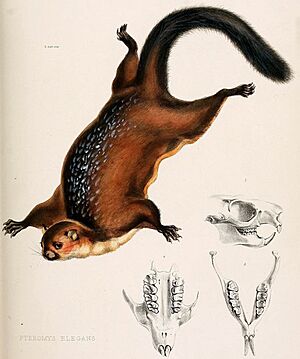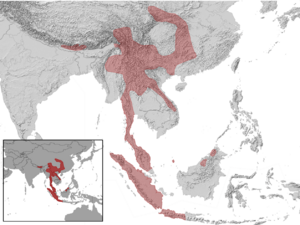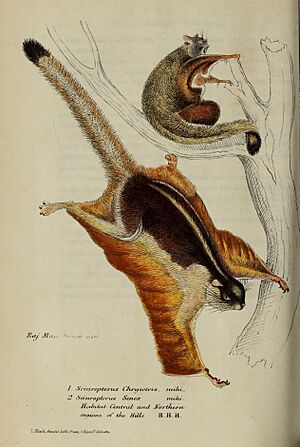Spotted giant flying squirrel facts for kids
Quick facts for kids Spotted Giant Flying Squirrel |
|
|---|---|
 |
|
| Conservation status | |
| Scientific classification | |
| Genus: |
Petaurista
|
| Species: |
elegans
|
 |
|
The spotted giant flying squirrel (Petaurista elegans) is also called the lesser giant flying squirrel. It is a type of rodent in the Sciuridae family, which includes squirrels.
You can find this squirrel in hill and mountain forests. It lives at high places, from about 200 to 4,000 meters (650 to 13,000 feet) up. Its home stretches across Southeast Asia, north to central China, and into the eastern Himalayan region.
Like other flying squirrels, it is active at night (nocturnal). It can glide long distances between trees. It does this by spreading out a special skin flap called a patagium between its legs. It doesn't actually fly like a bat.
This squirrel can be quite noisy. It often makes a long cry that you can hear at night. During the day, it rests in a hollow tree. Sometimes, it uses a cliff ledge or a nest made of plants in a tree. It eats fruits, seeds, leaves, buds, and flowers. It usually has one baby at a time, but sometimes two.
Different Kinds of Spotted Flying Squirrels
Scientists study how different animals are related. This is called taxonomy. For the spotted giant flying squirrel, it can be a bit tricky. Some squirrels that look like the spotted giant flying squirrel might actually be different species.
For example, the grey-headed giant flying squirrel (P. caniceps) looks quite different. Some scientists think it should be its own species. Other similar squirrels, like the Chindwin giant flying squirrel (P. sybilla), are also being studied.
These different types sometimes live in the same areas. This makes it harder to tell if they are one species or many. Scientists use genetic studies to learn more. These studies look at the animal's DNA.
What they found is that some of these squirrels are quite different from each other. Even though they look similar, their family trees split a long time ago. This means they might be separate species after all.
Appearance of the Spotted Giant Flying Squirrel
The spotted giant flying squirrel is a large squirrel. Its body is about 29.5 to 40 centimeters (11.5 to 15.5 inches) long. Its tail is also long, from 34 to 40.5 centimeters (13.5 to 16 inches). It weighs between 760 and 1,560 grams (1.7 to 3.4 pounds). Even though it's big, it's the smallest giant flying squirrel in its home range.
Its belly is light orange-brown or pale reddish-brown. The color of its head, back, and tail can change a lot. This depends on where the squirrel lives.
Some squirrels have a black tail. Only the part closest to the body is reddish-brown. For example, squirrels from the Thai-Malay Peninsula often have reddish-brown heads and backs. They have many white spots on their upper body. Sometimes, these spots are fewer.
Squirrels from northern Borneo are similar. But their upper head and back are black. This makes a clear difference with their reddish-brown sides. They also have white spots, but young squirrels might not have them.
Other squirrels have tails that are mostly or completely orange-brown or reddish-brown. Some from Mainland Southeast Asia are lighter brown on top. They have fewer white spots, mostly on their head and central back.
The grey-headed giant flying squirrel (P. e. caniceps) is special. Its body color is like some others. But it has a black tail tip and a completely grey head. It also has a white throat and an orange-brown ring around each eye. This type of squirrel does not have white spots on its body.



